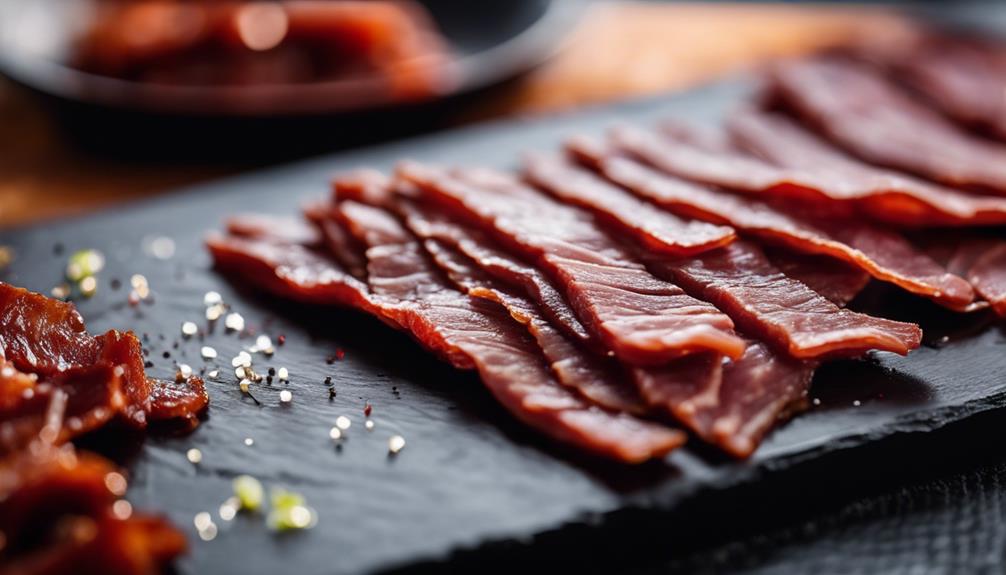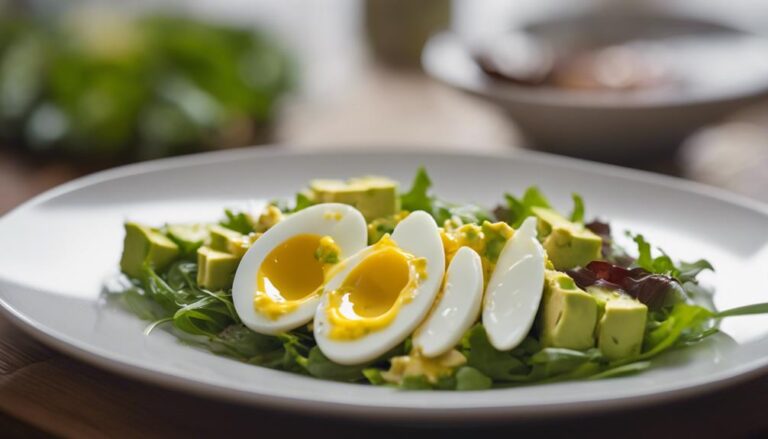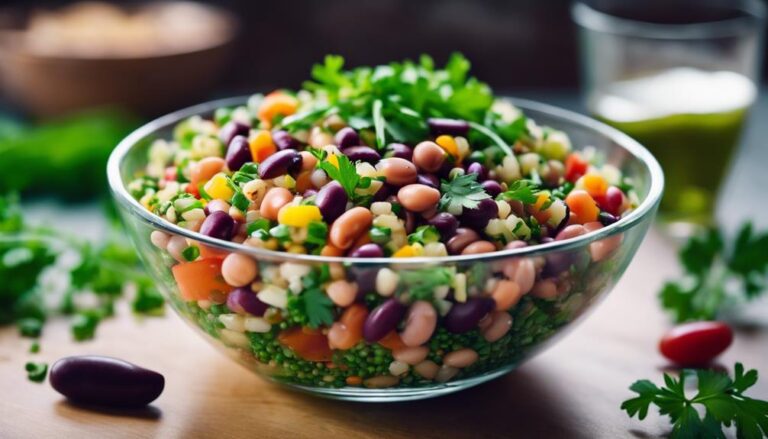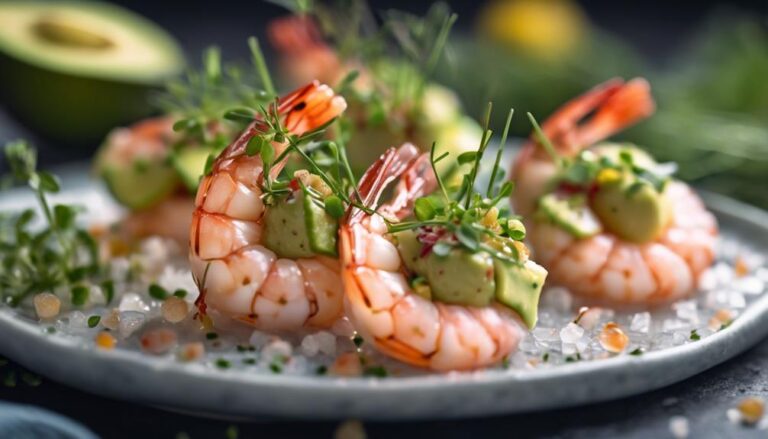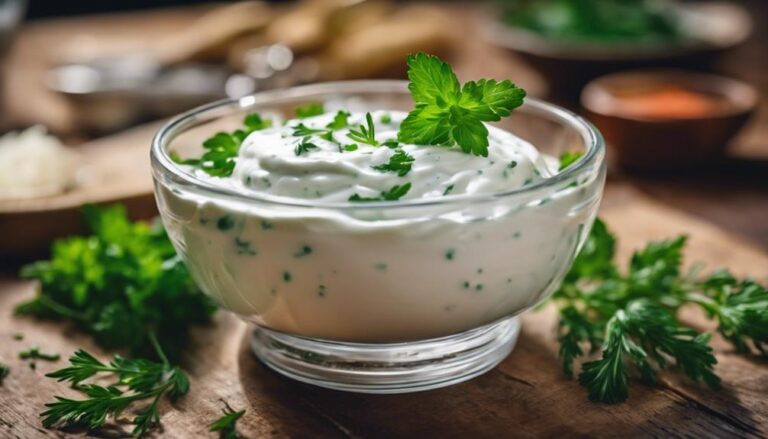Sous Vide Jerky (Beef or Turkey)
When you try sous vide jerky, whether beef or turkey, you'll savor perfectly cooked, tender strips bursting with flavor. Using precise temperature control, this method retains moisture, ensuring a delightful texture every time. The hands-off approach allows you to prepare large batches effortlessly. Elevate your culinary skills and amaze your taste buds with homemade jerky that consistently impresses. Explore a world of delicious possibilities in the domain of sous vide jerky that will redefine snack time for you, making each bite a culinary delight.
What You Will Learn Here
- Sous vide method ensures tender jerky with precise temperature control.
- Retains moisture and flavor for exceptional taste.
- Ideal for preparing large batches with minimal effort.
- Eliminates risk of overcooking, offering consistent results.
- Elevates culinary skills and impresses with homemade jerky.
Jerky's Evolution Over Time
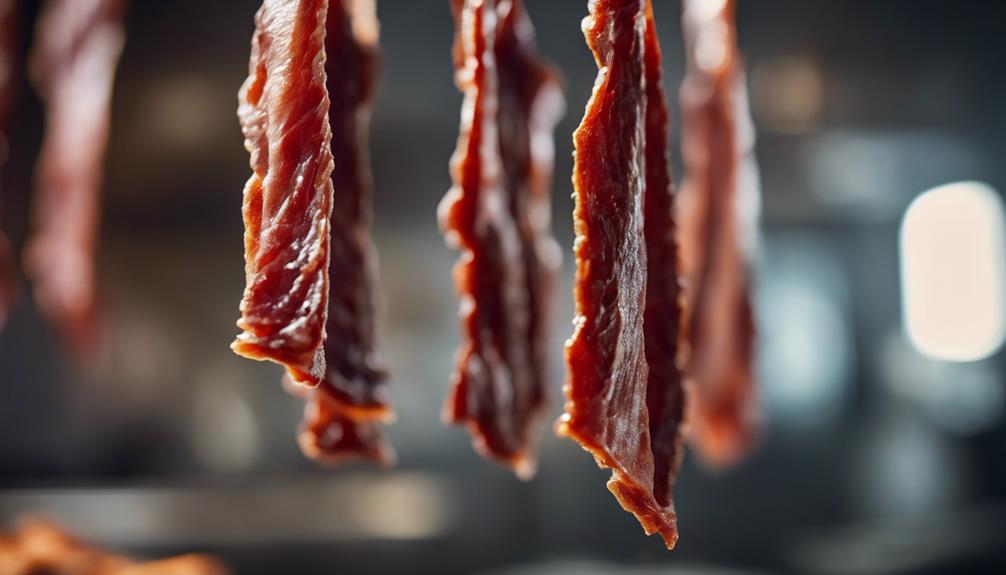
Jerky has undergone significant changes throughout history, adapting to new preservation techniques, developing diverse flavor profiles, and evolving in modern production methods.
Its journey from simple dried meat strips to a wide array of flavors and textures showcases the innovation and creativity within the jerky industry.
Jerky Preservation Techniques
How have preservation techniques influenced the evolution of this beloved dried meat snack over time?
Jerky's journey from ancient preservation methods to modern techniques has shaped its enduring appeal. Traditional jerky was crafted by drying strips of meat under the sun or smoking them over low heat to prevent spoilage. These drying methods not only preserved the meat but also intensified its flavor.
With advancements in technology, modern preservation techniques like curing with salt, marinating, and using dehydrators or ovens have become prevalent. These methods not only extend the shelf life of jerky but also allow for a wider range of flavors and textures.
The blend of traditional and modern preservation techniques continues to define the evolution of jerky as a delicious and convenient snack option.
Flavor Variations in Jerky
The evolution of flavor variations in jerky mirrors the diverse culinary preferences and innovative techniques that have shaped this beloved dried meat snack over time. Jerky has come a long way from traditional recipes to now include a wide array of flavors to cater to different tastes. Here are two popular flavor variations that have stood the test of time:
| Flavor Variations | Description |
|---|---|
| Sweet & tangy | Combines sweetness with a hint of tanginess, creating a balanced flavor profile that appeals to those who enjoy a mix of flavors. |
| Smoky & spicy | Offers a bold and fiery kick with a smoky undertone, ideal for individuals who prefer their jerky to have a flavorful punch. |
Modern Jerky Production
Exploring the advancements in jerky production reveals a fascinating journey of innovation and adaptation in the domain of dried meat preservation techniques.
Over time, jerky production has evolved greatly, with modern techniques like sous vide offering benefits such as precise temperature control for ideal meat drying and flavor retention. Jerky trends have shifted towards healthier options, emphasizing lean cuts of beef or turkey and using natural ingredients for flavoring.
Manufacturers have also started experimenting with unique flavor combinations and textures to cater to changing consumer preferences.
The modern jerky production landscape showcases an exciting fusion of traditional methods with cutting-edge technology, resulting in a wide array of high-quality jerky products that continue to captivate meat enthusiasts worldwide.
Key Jerky Components
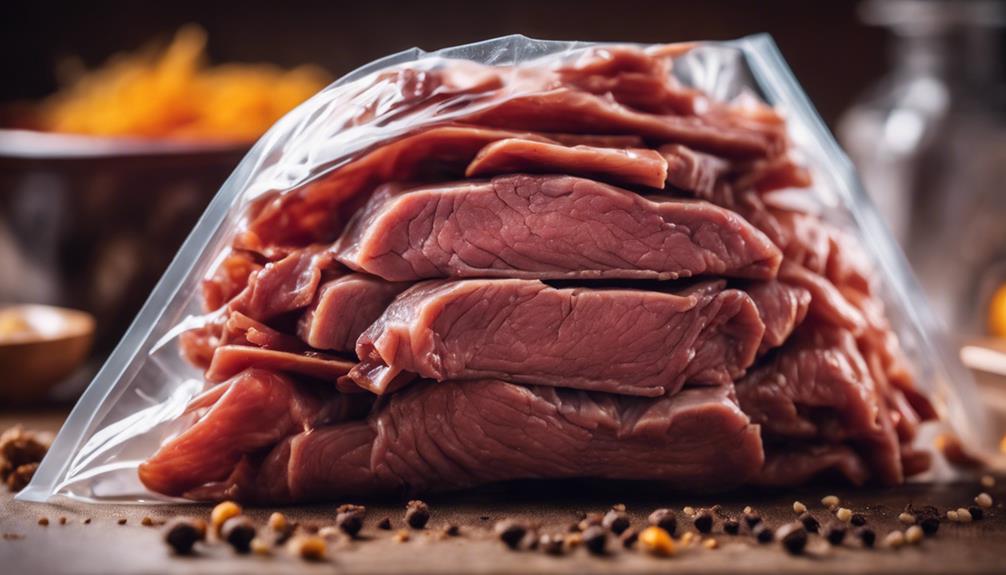
To create high-quality jerky, selecting quality meat is essential. When making jerky, the choice of meat and the ingredients used are vital in determining the final product's flavor and texture. Here are key components to take into account:
- Meat Selection: Opt for lean cuts like beef eye of round or turkey breast, as they dehydrate well and result in a chewy texture.
- Marinade Choices: Select a marinade that complements the meat. Common ingredients include soy sauce, Worcestershire sauce, honey, or maple syrup for sweetness, and spices like garlic, onion powder, and black pepper for flavor.
- Slicing Technique: Slice the meat against the grain into thin strips to ensure tenderness and easier chewing.
- Dehydration Method: Whether using a dehydrator, oven, or sous vide machine, maintain proper airflow and consistent low heat for even drying.
- Storage: Store jerky in airtight containers or vacuum-sealed bags to preserve freshness and prevent spoilage.
Jerky Variations
You can explore a range of jerky variations to suit different tastes and preferences.
Consider trying out a savory beef jerky recipe for a classic flavor.
Experiment with a turkey jerky recipe for a leaner option.
Opt for a spicy teriyaki jerky recipe for a bold and zesty twist.
Each variation offers a unique blend of flavors and textures, allowing you to customize your jerky experience to your liking.
Savory Beef Jerky Recipe
For a variety of jerky flavors, consider experimenting with different marinades and seasonings to create a range of savory beef jerky options. When making savory beef jerky, the marinade is essential for flavor infusion and tenderness. Try these options to elevate your jerky game:
- Classic Teriyaki: A sweet and savory blend with soy sauce, ginger, and garlic.
- Spicy Sriracha: Adds a kick with a mix of Sriracha, honey, and lime juice.
- Smoky BBQ: Perfect for a rich, smoky taste using a BBQ sauce base.
- Zesty Citrus: Brighten up your jerky with citrus flavors like orange and lemon.
- Garlic Pepper: A simple yet flavorful combination of garlic, pepper, and Worcestershire sauce.
Experiment with these marinades to find your favorite savory beef jerky flavor!
Turkey Jerky Recipe
Experiment with a new twist on jerky by trying out a flavorful Turkey Jerky Recipe that offers a unique and delicious alternative to traditional beef jerky options. When making Turkey Jerky, the key lies in the perfect balance of seasoning and the precise dehydration process. Here are some tips to help you create mouth-watering Turkey Jerky:
- Choose Lean Cuts: Opt for turkey breast meat for a healthier option.
- Marinate Overnight: Enhance flavor by marinating the turkey slices in a blend of your favorite seasonings.
- Slice Thinly: Guarantee even drying by slicing the turkey into thin strips.
- Monitor Dehydration Time: Check regularly to prevent over-drying.
- Store Properly: Keep your finished turkey jerky in an airtight container for lasting freshness.
Spicy Teriyaki Jerky Recipe
When crafting a Spicy Teriyaki Jerky Recipe, selecting the right blend of spices and marinating techniques is crucial for achieving a bold and savory flavor profile. To create the perfect Spicy Teriyaki Jerky, consider the following:
- Marinade experimentation: Try different combinations of soy sauce, ginger, garlic, and red pepper flakes to find the ideal balance.
- Flavor balancing: Adjust the sweetness of the teriyaki sauce with a hint of heat for a harmonious taste.
- Temperature precision: Maintain a consistent low temperature during the drying process to guarantee the meat is safe to eat.
- Meat tenderness: Slice the meat against the grain for a tender texture, and marinate it for the right amount of time to enhance tenderness.
- Patience: Allow the jerky to cool and rest before enjoying, intensifying the flavors.
Jerky Texture Adjustment
When aiming to adjust the texture of your jerky, consider these important points:
First, controlling the texture involves factors like the thickness of the slices and the drying time.
Second, infusing flavors can impact the final texture, from tender to chewy.
Lastly, selecting the right equipment, such as a quality dehydrator or oven, can help achieve the desired texture for your jerky.
Texture Control Tips
To improve the texture of your jerky, consider adjusting the cooking time and temperature in small increments until you achieve the desired consistency. Moisture control is essential in achieving the perfect jerky texture. Higher temperatures and longer cooking times will result in drier jerky, while lower temperatures and shorter cooking times will retain more moisture. Here is a table to guide you in adjusting your sous vide settings for texture control:
| Temperature (F) | Cooking Time (hours) | Texture |
|---|---|---|
| 140 | 5 | Chewy |
| 150 | 4 | Balanced |
| 160 | 3 | Crispy |
| 170 | 2 | Brittle |
| 180 | 1 | Very crispy |
Flavor Infusion Ideas
For enhanced flavor infusion in your jerky, experiment with marinades containing ingredients like soy sauce, Worcestershire sauce, or liquid smoke to complement your desired texture profile.
Fruit marinades can add a sweet and tangy dimension to your jerky, enhancing the overall taste experience. Consider using pineapple juice, apple cider vinegar, or orange zest to bring a fruity twist to your jerky flavors.
Herb seasonings, such as rosemary, thyme, or oregano, can provide a savory and aromatic touch to your jerky, elevating the taste to a new level. Try combining different herbs to create unique flavor profiles that suit your preferences.
Equipment Selection Guide
Enhance the texture of your jerky by selecting the appropriate equipment suited for adjusting its consistency and chewiness.
When choosing equipment for jerky texture adjustment, consider the cooking temperatures and cooking times needed to achieve the desired result.
For a firmer texture, opt for a dehydrator that allows you to set lower cooking temperatures for longer cooking times. Dehydrators offer precise control over the drying process, ensuring your jerky turns out just the way you like it.
If you prefer a chewier jerky, using an oven at slightly higher cooking temperatures for shorter cooking times might be more suitable.
Experiment with different equipment options to find the perfect balance of texture for your sous vide jerky.
Final Thoughts
Consider incorporating these key insights into your culinary repertoire as you reflect on this Sous Vide Jerky recipe. The benefits of using the sous vide method for making jerky are numerous. By cooking the meat at a precise temperature for an extended period, you guarantee that it's perfectly cooked while retaining its moisture and flavor. This results in a tender and flavorful jerky that's far superior to traditionally dried versions.
Reflecting on the process, you may appreciate the convenience of preparing a large batch of jerky with minimal hands-on time. The sous vide method allows you to set it and forget it, freeing you up to attend to other tasks while the meat cooks to perfection. Additionally, the precise temperature control of the sous vide cooker eliminates the risk of overcooking, ensuring that your jerky is consistently delicious every time.
Incorporating sous vide techniques into your jerky-making process can elevate your culinary skills and impress your family and friends with the exceptional flavor and texture of homemade jerky.
Frequently Asked Questions
Can Sous Vide Jerky Be Made Without a Vacuum Sealer?
Yes, you can make sous vide jerky without a vacuum sealer. Alternative methods like using ziplock bags work well. Try various flavor combinations for marinades to enhance taste. Experiment to discover your favorite jerky profile.
What Are the Best Storage Methods for Sous Vide Jerky?
For ideal storage of your sous vide jerky, focus on moisture control by using airtight containers. Consider refrigeration for short-term storage or freezing for longer preservation. These methods will help maintain the jerky's quality and freshness.
Is It Possible to Overcook Jerky Using the Sous Vide Method?
When using the sous vide method, you can overcook jerky if temperature control isn't precise. Achieving desired texture preferences and flavor profiles depend on monitoring doneness levels closely. Be attentive to avoid compromising the jerky's quality.
Can Different Cuts of Meat Be Used for Sous Vide Jerky?
When choosing meat for sous vide jerky, consider various cuts for diverse flavor profiles. Texture preferences guide selection, impacting chewiness. Experiment with seasoning techniques to enhance taste. Meat selection influences the final product's richness and tenderness.
How Long Does Sous Vide Jerky Typically Last in Storage?
When looking at the shelf life of jerky, consider various preservation methods. Storing jerky in airtight containers or vacuum-sealed bags extends its freshness. Keep jerky in a cool, dry place for longer-lasting enjoyment.
Conclusion
To sum up, sous vide jerky offers a modern twist on a classic snack, allowing for precise control over texture and flavor. By utilizing this cooking method, you can guarantee that your jerky is consistently tender and delicious.
Whether you prefer beef or turkey, sous vide jerky is a versatile and convenient option for satisfying your jerky cravings. Give it a try and experience the evolution of jerky for yourself.
